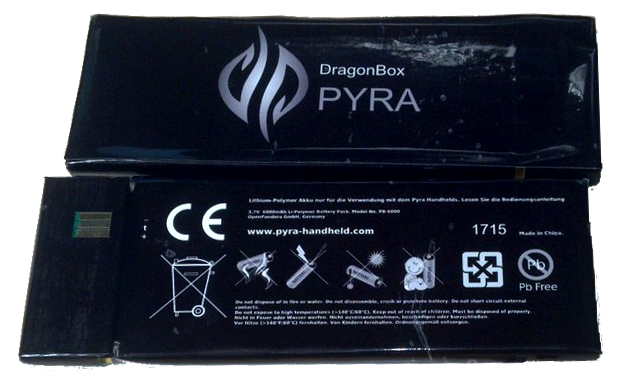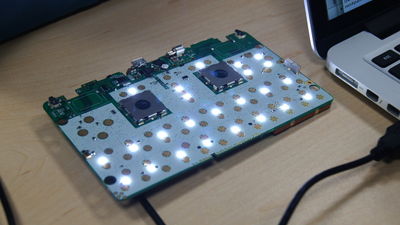A mess for now. Moving from Main page.
CPU
The OMAP5 (OMAP5432) is the SoC (System on Chip) of the Pyra. It's designed (and manufactured?) by Texas instruments. It resides on the CPU-Board, with these specifications:
- 2x ARM Cortex-A15 @ 1.5Ghz with NEON SIMD
- 2x ARM Cortex-M4
- PowerVR™ SGX544-MP2 (main GPU)
- Vivante GC320 2D Accelerator (also part of the GPU)
GPU
- PowerVR SGX SGX544-MP2
- Vivante GC320 2D Accelerator
- HDMI Encoder: HDMI 1.4a, HDCP 1.4, and DVI 1.0 Compliant" [1]
RAM
Dual Channel PC DDR3L 532MHz:
- 4 Ram-Chips on the CPU-Board at 4GBits density means 2GiB total, confirmed[1][2]
- 4GB could be possible [2]
- Chip type: IM4G(08/16)D3FABG Datasheet
Display
LCD screen
This is a 720p, 8-bits-per-channel LCD with a resistive touch-sensitive layer suitable for use with fingers as well as a high-precision passive stylus. Multi-touch detection is also possible to a limited degree.
The market for small LCDs is largely driven by smartphones, making it prohibitively difficult to source a native landscape display. As a result, the Pyra uses a portrait display, with a dedicated video rotation chip interfacing with the CPU/GPU
Tiler
The tiling and isometric lightweight engine for rotation (TILER) resides in the Memory Subsystem of the OMAP5 and Manages the virtual address, data, and byte-enable to match the requested 0-, 90-, 180-, or 270-degree orientation in a tiled 2D addressing space. Previously there was only an slow (because of Bugs) Driver Available, thus the decision above. Later an Community Member (Zmatt) wrote an new Driver, which performed perfectly.
Video Output
The Pyra has an digital video output supporting HDMI 1.4a, HDCP 1.4, and DVI 1.0 which can be used independently of and at higher resolutions than the built-in LCD. (Confirmation Needed)
USB
The Pyra has four USB ports, as detailed below.
For our purposes:
- "USB2" means "capable of Low, Full and High-speed"
- "USB3" means "capable of low, full, high and super-speed"
- "OTG" means capable of operating in either host- or slave-mode.
Full-size USB2 Port
This is a straightforward USB port as found on many desktop PCs. I can be used for keyboards, mice, USB memory sticks, network adaptors and many other things (subject to driver support)
Full-size USB2 Port with eSATA
This can be used as a simple USB2 port as above. Although this uses a blue Connector designed for USB3 Ports, it is not capable of USB3 (with the current CPU-Board). The additional pins are used for (e-)SATA Lanes for to an Adapter. See Storage for more details.
Micro-USB3 OTG Port
This can be used much like the full-size USB2 ports, but at higher speeds and with the obvious requirement for a passive adaptor when using most peripherals. It can also be used to charge the Pyra (either from another computer, or a mains adaptor) and to operate as a USB slave. The Pandora has software allowing it to operate as a USB mouse, joystick, keyboard or SD-card reader in slave mode. It is expected that similar software will be available for the Pyra.
Serial-via-micro-USB Port
This is not a general-purpose USB port (as a result of limitations of the SOC) but can be used in two ways:
- Charging the Pyra while the primary microUSB3 port is in host mode.
- Monitoring the Pyra using another computer (Serial output from the Pyra's processor, via a built-in Serial-USB translator, with the Pyra as USB slave)
Radio
WiFi
The Pyra's Wifi and Bluetooth systems are both provided by a Texas Instruments WL1837MOD
This supports 802.11abgn on the 2.4GHz and 5GHz bands.
Max data rate (40 MHz channel and 400 ns GI): 150Mbps
Real conditions by TI: 80 Mbps (TCP), 100 Mbps (UDP)
Bluetooth
The Pyra's Bluetooth and WiFi systems are both provided by a Texas Instruments WL1837MOD
This supports Bluetooth 4.1[3] and BLE.
Software support should be available for (at least) file transfer and A2DP audio. This means all standard Bluetooth headphones and speakers will (probably) work.
Audio
Jack
- 3.5mm headset TRRS (stereo audio and microphone) connector with automatic switch to go from OMTP to CTIA as seen here
Volume Wheel
- Potentiometer to GPIO input in SoC, 10-Bit Resolution (allows software override of volume control)
Microphone
- Microphone located at the left edge between keyboard and D-pad.
Speakers
- Stereo speakers in base with tuned cavity behind them as per manufacturers' recommendations.
Batteries
Features and specifications
- Battery is easily removable and replaceable (though no hot swapping?)
- 6Ah Li-Po battery (at a nominal 3.7V, for approximately 22Wh)
- Can be charged in the Pyra using either of two microUSB ports (one carries USB3.0 otg, the other serial debug data)
- ?weight of cable, length of cable, environmental info.
Battery life
- Everyday work load: 8 hours (without any power management features, tested on prototype April 2016)
- Everything on (Bluetooth, WiFi, etc.): TBD
- Display off, audio on: TBD
- Suspend mode (display off, audio off, CPU running): TBD
Charger
The Pyra will charge from a standard microUSB cable, much in the same way as any other (non-apple) portable device made in the last few years.
Sample of potentially official charger
Storage
The Pyra has a range of options for data storage.
Internal eMMC Memory
Solid-state memory with 32GB capacity on the detachable CPU-Board, where the default operating system will be installed, and where you can put games, applications, and other content.
SD Card Slots
The Pyra has two full-sized SDXC card slots, externally accessible, via an MMC interface (not USB).
It also has a microSDXC card slot behind the battery, which shares with the internal eMMC memory the same interface to the SOC, but which is controlled by a software-managed switch. This theoretically allows both to be accessed near-simultaneously, albeit with a decrease in throughput.
eSATA via Adapter
eSATA support comes via an active Adapter which plugs into a USB port, but it is not a USB-to-eSATA adapter -- the additional pins that would normally be taken up with USB 3.0 signalling have been used for SATA signals. This allows far higher transfer rates than would be possible over USB. In addition, should a SOC become available in future with a second USB 3.0 interface, it could be routed through the existing connector to provide a dedicated USB 3.0 host port.
Miscellaneous
Other data storage options:
- Two USB 2.0 host ports, can connect flash drives etc.
- One microUSB 3.0 otg (host-slave) port (can also be used for charging)
- One SIM card slot (behind battery, on models with WWAN hardware)
LEDs
- Two independent RGB LEDs behind the logo on the back of the lid
- Two RGB LEDs on near the power button
- One RGB LED underneath the power button
- Several white LEDs used to backlight the keyboard (These can be controlled in groups, see video for demo)







